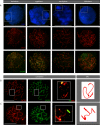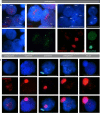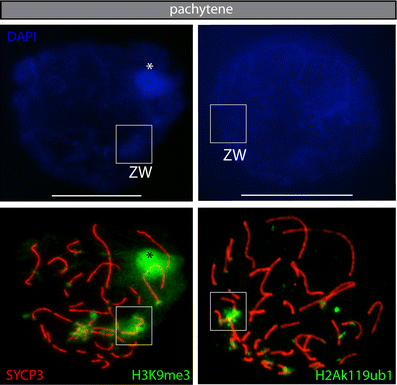Meiotic silencing and fragmentation of the male germline restricted chromosome in zebra finch
- PMID: 20162291
- PMCID: PMC2875885
- DOI: 10.1007/s00412-010-0258-9
Meiotic silencing and fragmentation of the male germline restricted chromosome in zebra finch
Abstract
During male meiotic prophase in mammals, X and Y are in a largely unsynapsed configuration, which is thought to trigger meiotic sex chromosome inactivation (MSCI). In avian species, females are ZW, and males ZZ. Although Z and W in chicken oocytes show complete, largely heterologous synapsis, they too undergo MSCI, albeit only transiently. The W chromosome is already inactive in early meiotic prophase, and inactive chromatin marks may spread on to the Z upon synapsis. Mammalian MSCI is considered as a specialised form of the general meiotic silencing mechanism, named meiotic silencing of unsynapsed chromatin (MSUC). Herein, we studied the avian form of MSUC, by analysing the behaviour of the peculiar germline restricted chromosome (GRC) that is present as a single copy in zebra finch spermatocytes. In the female germline, this chromosome is present in two copies, which normally synapse and recombine. In contrast, during male meiosis, the single GRC is always eliminated. We found that the GRC in the male germline is silenced from early leptotene onwards, similar to the W chromosome in avian oocytes. The GRC remains largely unsynapsed throughout meiotic prophase I, although patches of SYCP1 staining indicate that part of the GRC may self-synapse. In addition, the GRC is largely devoid of meiotic double strand breaks. We observed a lack of the inner centromere protein INCENP on the GRC and elimination of the GRC following metaphase I. Subsequently, the GRC forms a micronucleus in which the DNA is fragmented. We conclude that in contrast to MSUC in mammals, meiotic silencing of this single chromosome in the avian germline occurs prior to, and independent of DNA double strand breaks and chromosome pairing, hence we have named this phenomenon meiotic silencing prior to synapsis (MSPS).
Figures







Similar articles
-
Female meiotic sex chromosome inactivation in chicken.PLoS Genet. 2009 May;5(5):e1000466. doi: 10.1371/journal.pgen.1000466. Epub 2009 May 22. PLoS Genet. 2009. PMID: 19461881 Free PMC article.
-
Incomplete meiotic sex chromosome inactivation in the domestic dog.BMC Genomics. 2015 Apr 12;16(1):291. doi: 10.1186/s12864-015-1501-9. BMC Genomics. 2015. PMID: 25884295 Free PMC article.
-
SPO11-independent DNA repair foci and their role in meiotic silencing.PLoS Genet. 2013 Jun;9(6):e1003538. doi: 10.1371/journal.pgen.1003538. Epub 2013 Jun 6. PLoS Genet. 2013. PMID: 23754961 Free PMC article.
-
Small RNAs and their protein partners in animal meiosis.Curr Top Dev Biol. 2023;151:245-279. doi: 10.1016/bs.ctdb.2022.06.001. Epub 2022 Jul 25. Curr Top Dev Biol. 2023. PMID: 36681472 Review.
-
DNA double strand break repair, chromosome synapsis and transcriptional silencing in meiosis.Epigenetics. 2010 May 16;5(4):255-66. doi: 10.4161/epi.5.4.11518. Epub 2010 May 16. Epigenetics. 2010. PMID: 20364103 Review.
Cited by
-
Unravelling the mystery of female meiotic drive: where we are.Open Biol. 2021 Sep;11(9):210074. doi: 10.1098/rsob.210074. Epub 2021 Sep 1. Open Biol. 2021. PMID: 34465214 Free PMC article. Review.
-
Mendelian nightmares: the germline-restricted chromosome of songbirds.Chromosome Res. 2022 Sep;30(2-3):255-272. doi: 10.1007/s10577-022-09688-3. Epub 2022 Apr 13. Chromosome Res. 2022. PMID: 35416568 Free PMC article. Review.
-
Occasional paternal inheritance of the germline-restricted chromosome in songbirds.Proc Natl Acad Sci U S A. 2022 Jan 25;119(4):e2103960119. doi: 10.1073/pnas.2103960119. Proc Natl Acad Sci U S A. 2022. PMID: 35058355 Free PMC article.
-
Germline-specific labeling of the somatic chromosomes by protein phosphatase 2A and histone H3S28 phosphorylation in Acricotopus lucidus.Protoplasma. 2017 Sep;254(5):1983-1993. doi: 10.1007/s00709-017-1092-1. Epub 2017 Mar 6. Protoplasma. 2017. PMID: 28265764 Free PMC article.
-
Germline-restricted chromosome (GRC) is widespread among songbirds.Proc Natl Acad Sci U S A. 2019 Jun 11;116(24):11845-11850. doi: 10.1073/pnas.1817373116. Epub 2019 Apr 29. Proc Natl Acad Sci U S A. 2019. PMID: 31036668 Free PMC article.
References
Publication types
MeSH terms
LinkOut - more resources
Full Text Sources

